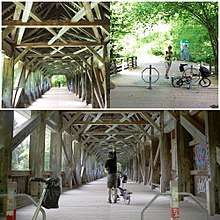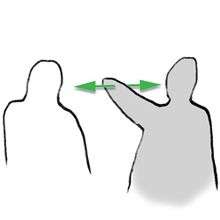Dualphotography
Dualphotography is a photographic technique simultaneously taking two photographs (a dualphoto) of one scene, thus photographing a scene from both sides of a photographic device at once.

The dualphoto apparatus can be used to simultaneously capture both the subject and the photographer, or both sides of a geographical place at once, thus adding a supplementary narrative layer to that of a single image. Dual photography includes back-to-back photography and portal-plane photography.[1]
Stereoscopy is a specific kind of dualphotography, and while it is technically similar and would be compatible with the term, the latter is seldom used for it.
Etymology
The word "dualphotography" comes from the combination of "dual" from the Latin root dualis (“two”) and the word "photography". It is the application and practice of creating a photographic scene from two opposing or complementary sides of a simultaneous real-world situation.
Techniques
Back-to-back


Back-to-back dualphotography is done with two cameras taking pictures at 180 degrees opposition, thus excluding the photographer and camera from the scene. It has been made popular by smartphone apps as smartphone usually have two cameras standard, one on front for selfies, the other on the back for more traditional photographs, thus a complete dualcamera.
There are some examples of two traditional cameras attached together and mechanically synchronised to capture simultaneously.
 Removing camera and photographer from a scene thanks to the dualphoto technique.
Removing camera and photographer from a scene thanks to the dualphoto technique. An intense moment at a soccer match in Madrid, catching the public and the players at once during a penalty.
An intense moment at a soccer match in Madrid, catching the public and the players at once during a penalty. A dualphoto in between two blossoming cherry trees.
A dualphoto in between two blossoming cherry trees. A filtered dualphoto (using the bootymachine.net inspired filter from the Duall Dualphoto app) of Geneva lake and the docks.
A filtered dualphoto (using the bootymachine.net inspired filter from the Duall Dualphoto app) of Geneva lake and the docks. A dualphoto of the food and its accompanying wine.
A dualphoto of the food and its accompanying wine. A dualphoto of the urban infrastructure.
A dualphoto of the urban infrastructure.
Portal-plane
Portal-plane dualphotography is for dualphotos taken by two distant cameras with gps and gyroscopic abilities, linked by means of wireless transmission and both client and server-side software. It effectively removes the space between the two cameras and creates a single scene between two geographical places with two photos being off-facing each other.
 An example of an ambiance / urban portal-plane dualphoto.
An example of an ambiance / urban portal-plane dualphoto. An example of a street portal-plane dualphoto.
An example of a street portal-plane dualphoto. An example of an abstract filtered (here with the square filter from the Duall Dualphoto app) portal-plane dualphoto.
An example of an abstract filtered (here with the square filter from the Duall Dualphoto app) portal-plane dualphoto. An example of a random portal-plane dualphoto.
An example of a random portal-plane dualphoto.
Equipment

Dualphotography requires a dualcamera. Modern smartphones with specific software can let one take dualphotographs, but hardware equipment, both digital and film-based can be found (usually custom built).
References
- ↑ "An introduction to Dualphotography". Medium.com Dual.Photo publication.
External links
- Duall Dualphoto a free iOS app for dualphotography.
- Camare is a free pro-oriented iOS app for 'pro' multi-lens photography but with various dualphotography settings.
- A dualphotography themed photocollective session (album).
- Arles Photo Festival Folio Review Dualphotography album by photographer Tristan Zand.